TOYOTA IQ 2012 Owners Manual
Manufacturer: TOYOTA, Model Year: 2012, Model line: IQ, Model: TOYOTA IQ 2012Pages: 476, PDF Size: 23.52 MB
Page 221 of 476
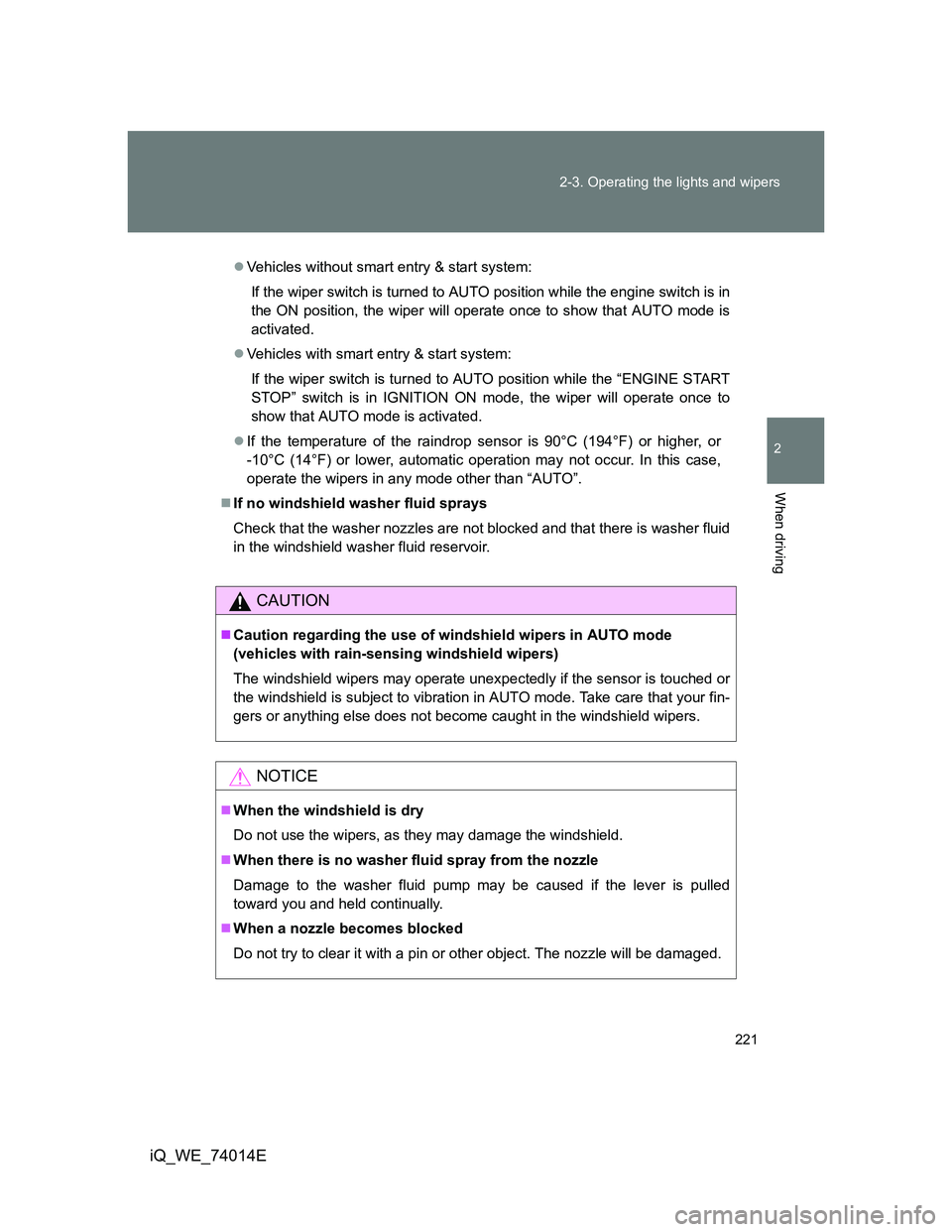
221 2-3. Operating the lights and wipers
2
When driving
iQ_WE_74014E
Vehicles without smart entry & start system:
If the wiper switch is turned to AUTO position while the engine switch is in
the ON position, the wiper will operate once to show that AUTO mode is
activated.
Vehicles with smart entry & start system:
If the wiper switch is turned to AUTO position while the “ENGINE START
STOP” switch is in IGNITION ON mode, the wiper will operate once to
show that AUTO mode is activated.
If the temperature of the raindrop sensor is 90°C (194°F) or higher, or
-10°C (14°F) or lower, automatic operation may not occur. In this case,
operate the wipers in any mode other than “AUTO”.
If no windshield washer fluid sprays
Check that the washer nozzles are not blocked and that there is washer fluid
in the windshield washer fluid reservoir.
CAUTION
Caution regarding the use of windshield wipers in AUTO mode
(vehicles with rain-sensing windshield wipers)
The windshield wipers may operate unexpectedly if the sensor is touched or
the windshield is subject to vibration in AUTO mode. Take care that your fin-
gers or anything else does not become caught in the windshield wipers.
NOTICE
When the windshield is dry
Do not use the wipers, as they may damage the windshield.
When there is no washer fluid spray from the nozzle
Damage to the washer fluid pump may be caused if the lever is pulled
toward you and held continually.
When a nozzle becomes blocked
Do not try to clear it with a pin or other object. The nozzle will be damaged.
Page 222 of 476
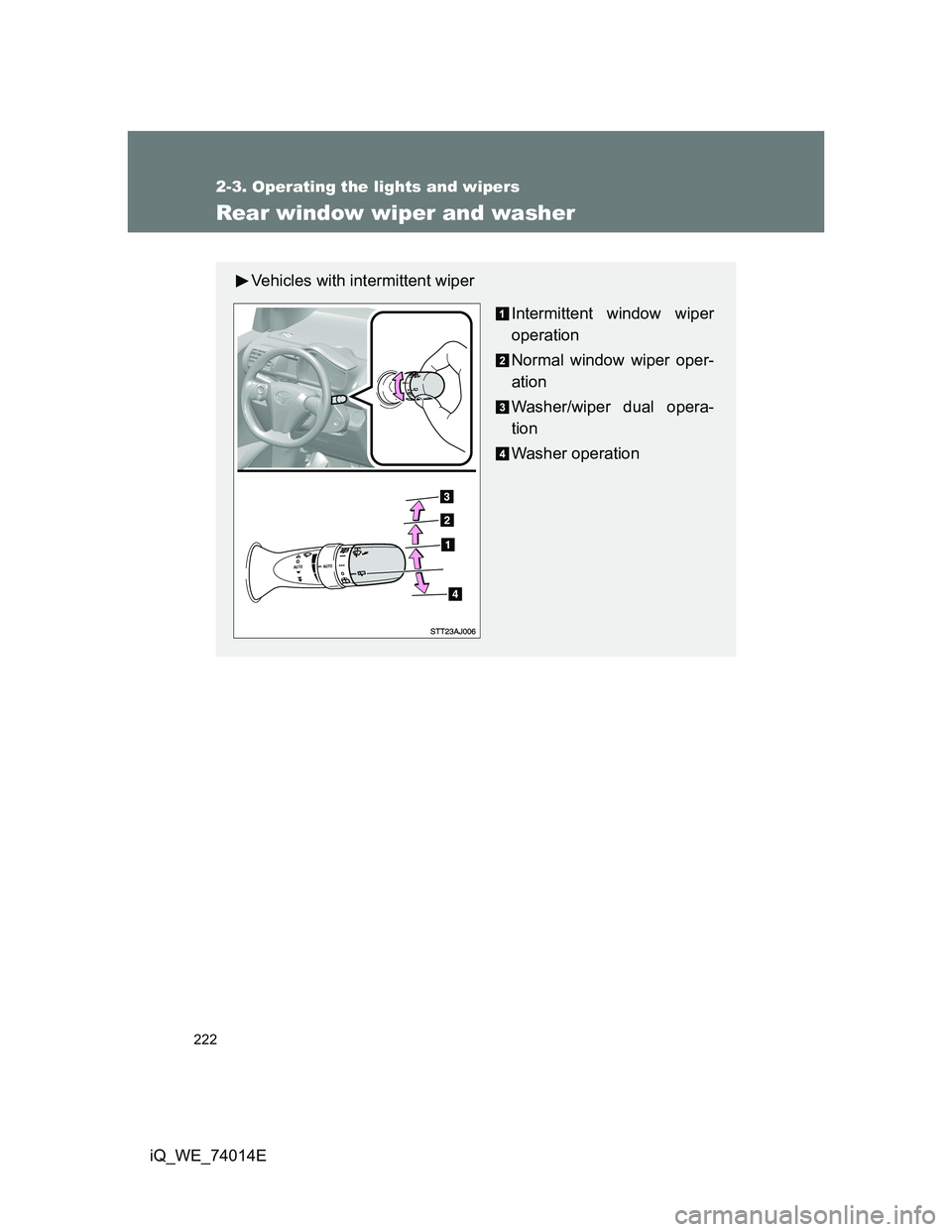
222
2-3. Operating the lights and wipers
iQ_WE_74014E
Rear window wiper and washer
Vehicles with intermittent wiper
Intermittent window wiper
operation
Normal window wiper oper-
ation
Washer/wiper dual opera-
tion
Washer operation
Page 223 of 476
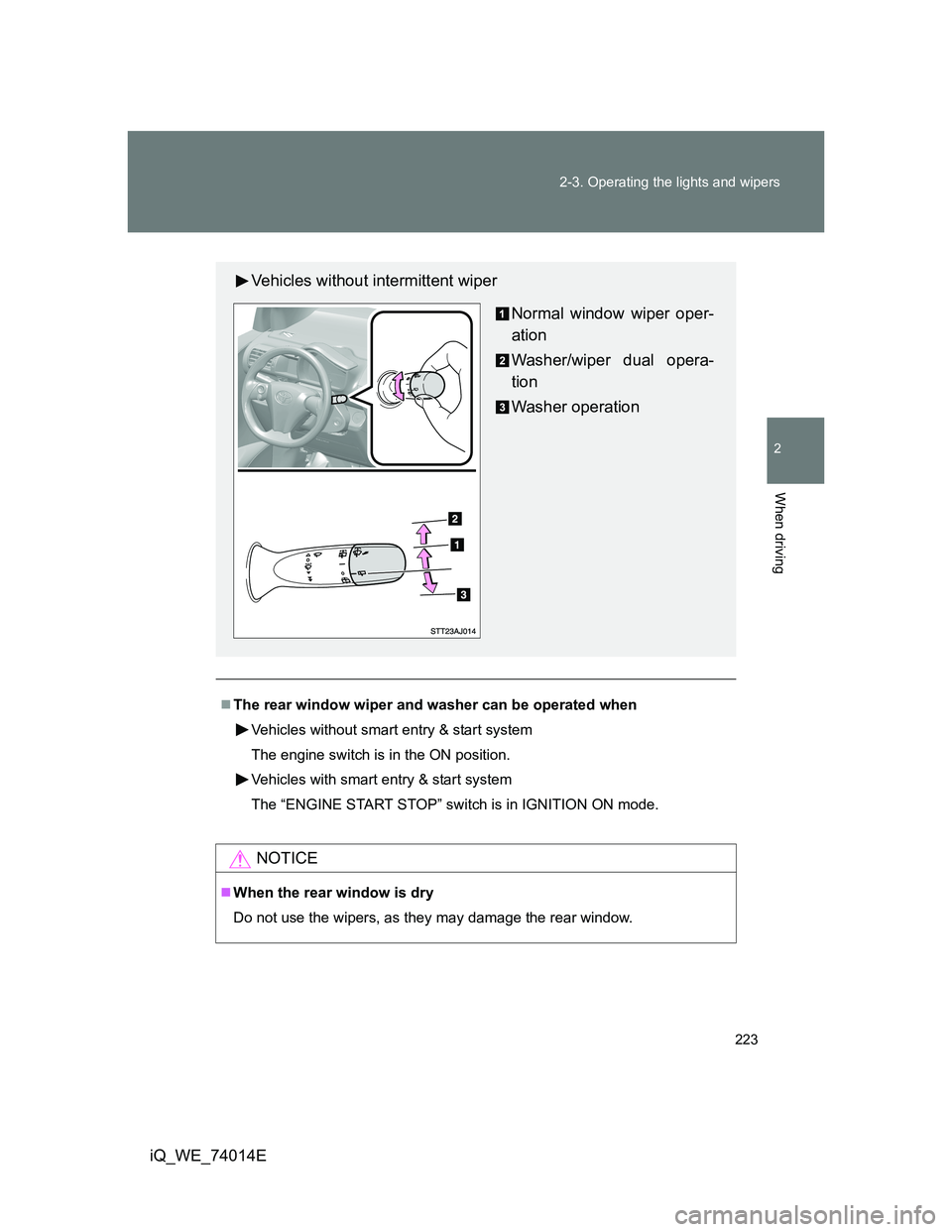
223 2-3. Operating the lights and wipers
2
When driving
iQ_WE_74014E
The rear window wiper and washer can be operated when
Vehicles without smart entry & start system
The engine switch is in the ON position.
Vehicles with smart entry & start system
The “ENGINE START STOP” switch is in IGNITION ON mode.
NOTICE
When the rear window is dry
Do not use the wipers, as they may damage the rear window.
Vehicles without intermittent wiper
Normal window wiper oper-
ation
Washer/wiper dual opera-
tion
Washer operation
Page 224 of 476
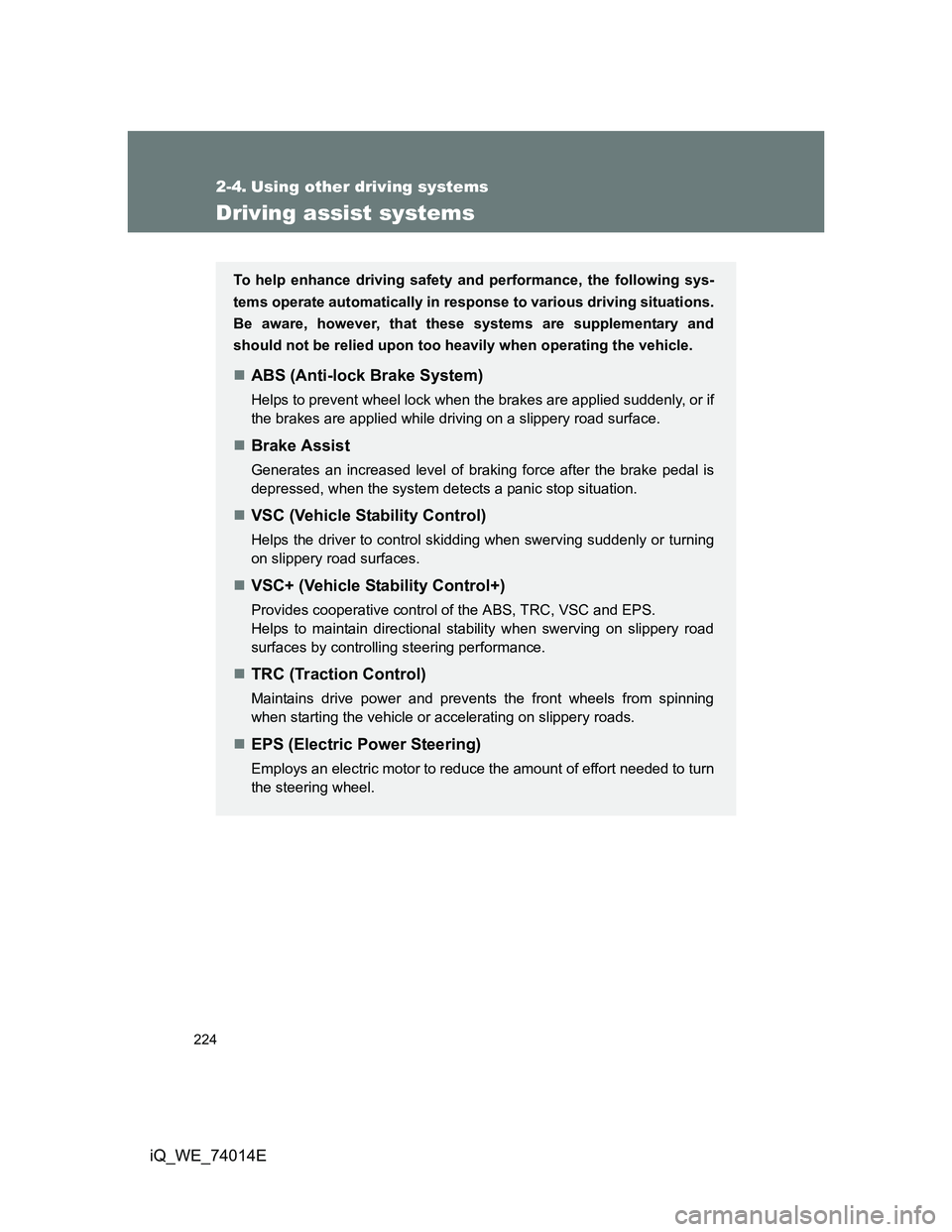
224
iQ_WE_74014E
2-4. Using other driving systems
Driving assist systems
To help enhance driving safety and performance, the following sys-
tems operate automatically in response to various driving situations.
Be aware, however, that these systems are supplementary and
should not be relied upon too heavily when operating the vehicle.
ABS (Anti-lock Brake System)
Helps to prevent wheel lock when the brakes are applied suddenly, or if
the brakes are applied while driving on a slippery road surface.
Brake Assist
Generates an increased level of braking force after the brake pedal is
depressed, when the system detects a panic stop situation.
VSC (Vehicle Stability Control)
Helps the driver to control skidding when swerving suddenly or turning
on slippery road surfaces.
VSC+ (Vehicle Stability Control+)
Provides cooperative control of the ABS, TRC, VSC and EPS.
Helps to maintain directional stability when swerving on slippery road
surfaces by controlling steering performance.
TRC (Traction Control)
Maintains drive power and prevents the front wheels from spinning
when starting the vehicle or accelerating on slippery roads.
EPS (Electric Power Steering)
Employs an electric motor to reduce the amount of effort needed to turn
the steering wheel.
Page 225 of 476
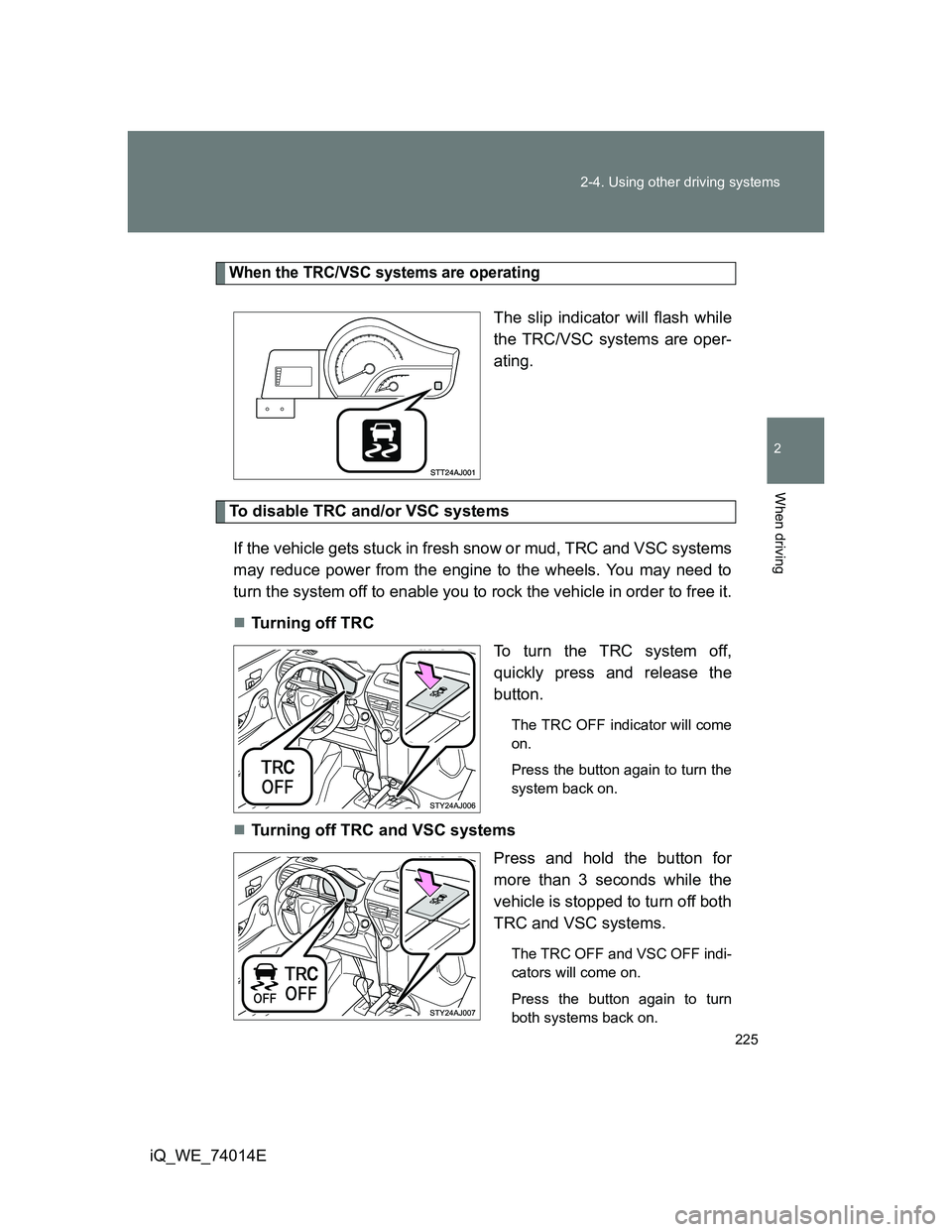
225 2-4. Using other driving systems
2
When driving
iQ_WE_74014E
When the TRC/VSC systems are operating
The slip indicator will flash while
the TRC/VSC systems are oper-
ating.
To disable TRC and/or VSC systems
If the vehicle gets stuck in fresh snow or mud, TRC and VSC systems
may reduce power from the engine to the wheels. You may need to
turn the system off to enable you to rock the vehicle in order to free it.
Turning off TRC
To turn the TRC system off,
quickly press and release the
button.
The TRC OFF indicator will come
on.
Press the button again to turn the
system back on.
Turning off TRC and VSC systems
Press and hold the button for
more than 3 seconds while the
vehicle is stopped to turn off both
TRC and VSC systems.
The TRC OFF and VSC OFF indi-
cators will come on.
Press the button again to turn
both systems back on.
Page 226 of 476
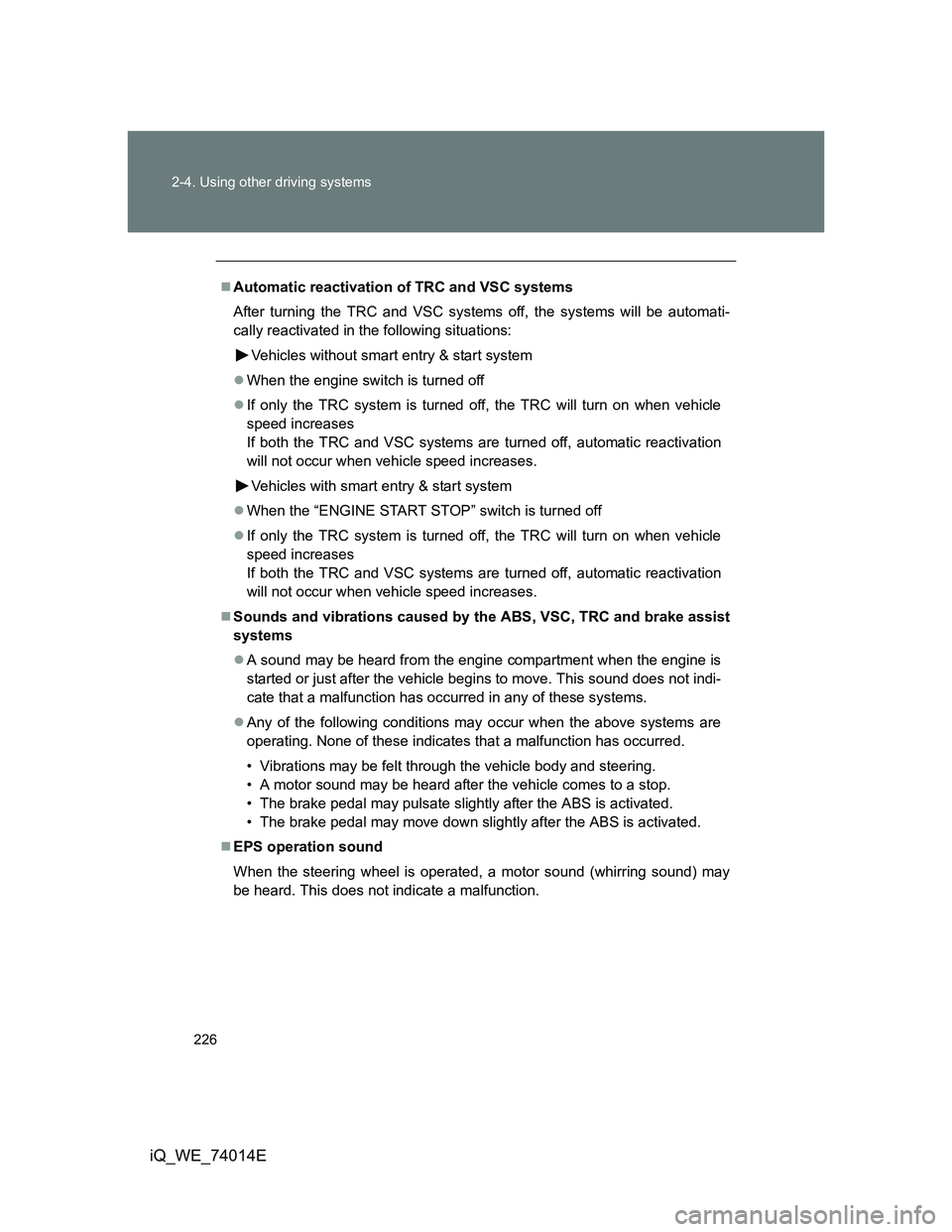
226 2-4. Using other driving systems
iQ_WE_74014E
Automatic reactivation of TRC and VSC systems
After turning the TRC and VSC systems off, the systems will be automati-
cally reactivated in the following situations:
Vehicles without smart entry & start system
When the engine switch is turned off
If only the TRC system is turned off, the TRC will turn on when vehicle
speed increases
If both the TRC and VSC systems are turned off, automatic reactivation
will not occur when vehicle speed increases.
Vehicles with smart entry & start system
When the “ENGINE START STOP” switch is turned off
If only the TRC system is turned off, the TRC will turn on when vehicle
speed increases
If both the TRC and VSC systems are turned off, automatic reactivation
will not occur when vehicle speed increases.
Sounds and vibrations caused by the ABS, VSC, TRC and brake assist
systems
A sound may be heard from the engine compartment when the engine is
started or just after the vehicle begins to move. This sound does not indi-
cate that a malfunction has occurred in any of these systems.
Any of the following conditions may occur when the above systems are
operating. None of these indicates that a malfunction has occurred.
• Vibrations may be felt through the vehicle body and steering.
• A motor sound may be heard after the vehicle comes to a stop.
• The brake pedal may pulsate slightly after the ABS is activated.
• The brake pedal may move down slightly after the ABS is activated.
EPS operation sound
When the steering wheel is operated, a motor sound (whirring sound) may
be heard. This does not indicate a malfunction.
Page 227 of 476
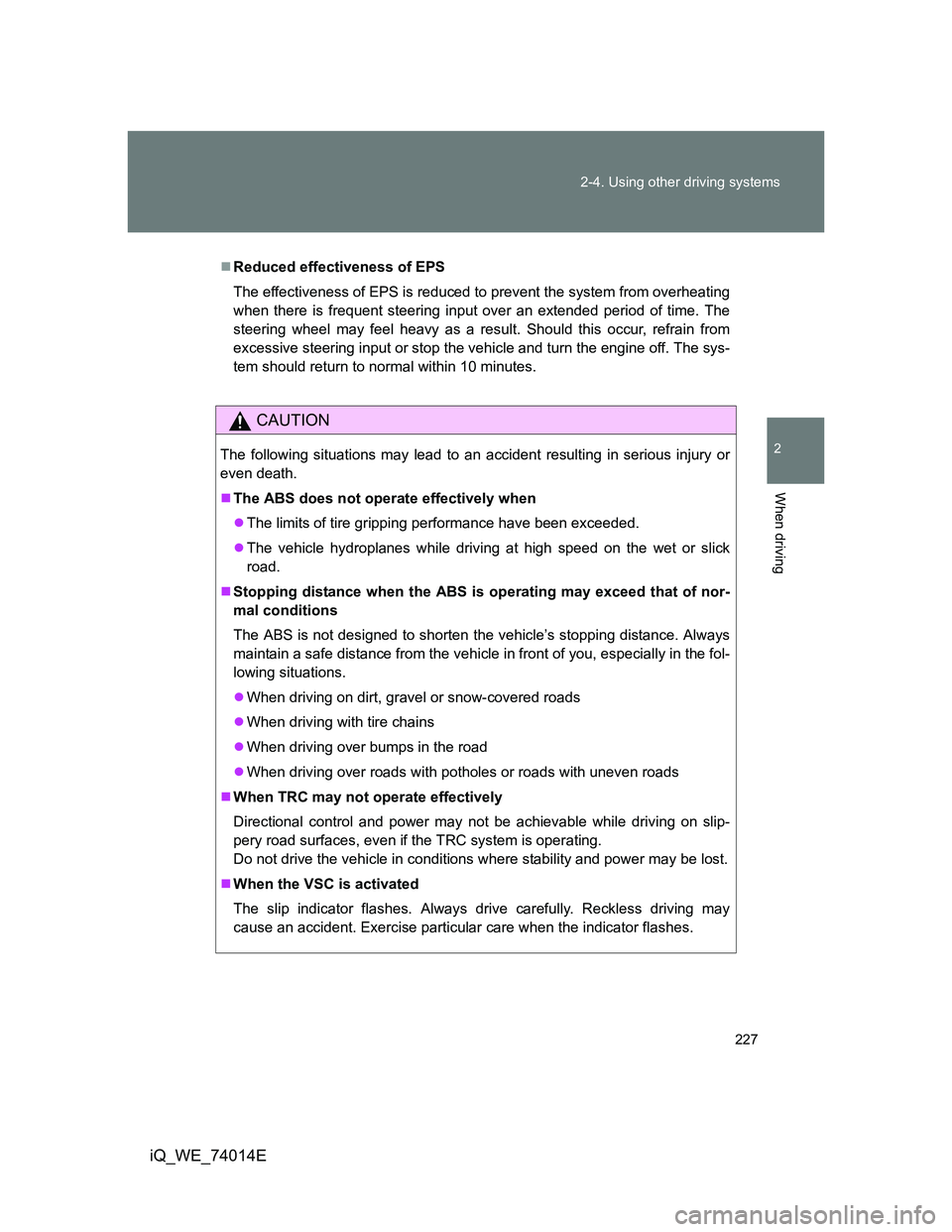
227 2-4. Using other driving systems
2
When driving
iQ_WE_74014E
Reduced effectiveness of EPS
The effectiveness of EPS is reduced to prevent the system from overheating
when there is frequent steering input over an extended period of time. The
steering wheel may feel heavy as a result. Should this occur, refrain from
excessive steering input or stop the vehicle and turn the engine off. The sys-
tem should return to normal within 10 minutes.
CAUTION
The following situations may lead to an accident resulting in serious injury or
even death.
The ABS does not operate effectively when
The limits of tire gripping performance have been exceeded.
The vehicle hydroplanes while driving at high speed on the wet or slick
road.
Stopping distance when the ABS is operating may exceed that of nor-
mal conditions
The ABS is not designed to shorten the vehicle’s stopping distance. Always
maintain a safe distance from the vehicle in front of you, especially in the fol-
lowing situations.
When driving on dirt, gravel or snow-covered roads
When driving with tire chains
When driving over bumps in the road
When driving over roads with potholes or roads with uneven roads
When TRC may not operate effectively
Directional control and power may not be achievable while driving on slip-
pery road surfaces, even if the TRC system is operating.
Do not drive the vehicle in conditions where stability and power may be lost.
When the VSC is activated
The slip indicator flashes. Always drive carefully. Reckless driving may
cause an accident. Exercise particular care when the indicator flashes.
Page 228 of 476
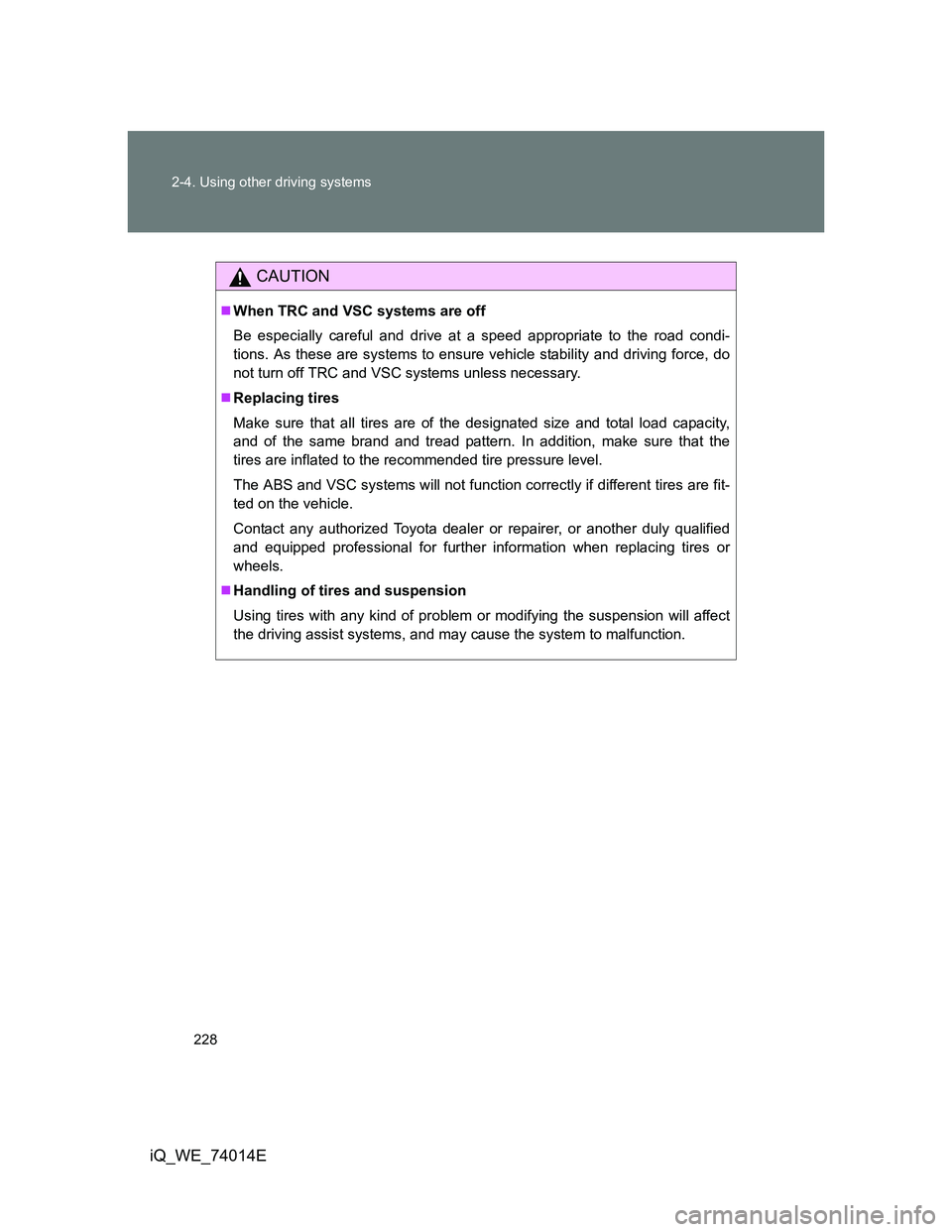
228 2-4. Using other driving systems
iQ_WE_74014E
CAUTION
When TRC and VSC systems are off
Be especially careful and drive at a speed appropriate to the road condi-
tions. As these are systems to ensure vehicle stability and driving force, do
not turn off TRC and VSC systems unless necessary.
Replacing tires
Make sure that all tires are of the designated size and total load capacity,
and of the same brand and tread pattern. In addition, make sure that the
tires are inflated to the recommended tire pressure level.
The ABS and VSC systems will not function correctly if different tires are fit-
ted on the vehicle.
Contact any authorized Toyota dealer or repairer, or another duly qualified
and equipped professional for further information when replacing tires or
wheels.
Handling of tires and suspension
Using tires with any kind of problem or modifying the suspension will affect
the driving assist systems, and may cause the system to malfunction.
Page 229 of 476
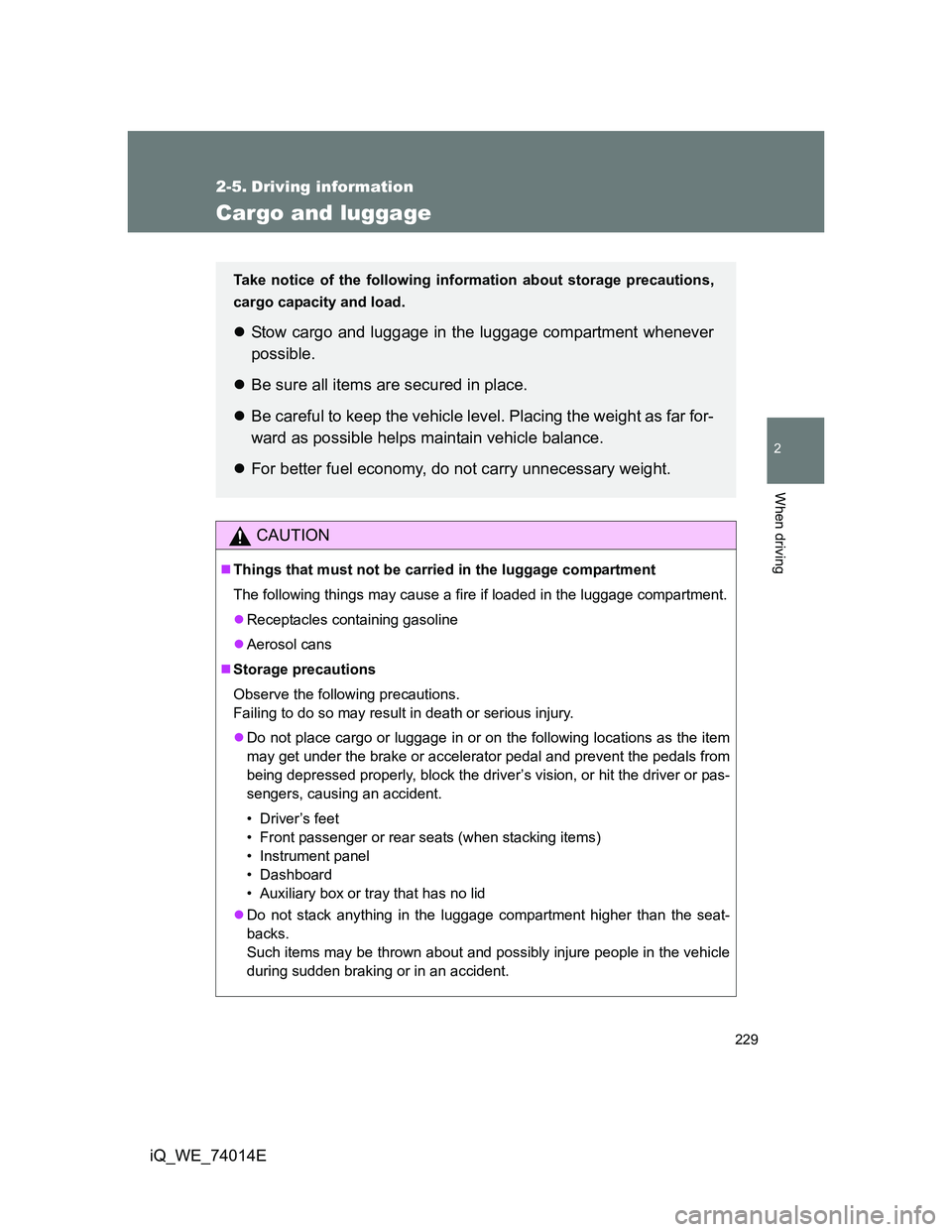
229
2
When driving
iQ_WE_74014E
2-5. Driving information
Cargo and luggage
CAUTION
Things that must not be carried in the luggage compartment
The following things may cause a fire if loaded in the luggage compartment.
Receptacles containing gasoline
Aerosol cans
Storage precautions
Observe the following precautions.
Failing to do so may result in death or serious injury.
Do not place cargo or luggage in or on the following locations as the item
may get under the brake or accelerator pedal and prevent the pedals from
being depressed properly, block the driver’s vision, or hit the driver or pas-
sengers, causing an accident.
• Driver’s feet
• Front passenger or rear seats (when stacking items)
• Instrument panel
• Dashboard
• Auxiliary box or tray that has no lid
Do not stack anything in the luggage compartment higher than the seat-
backs.
Such items may be thrown about and possibly injure people in the vehicle
during sudden braking or in an accident.
Take notice of the following information about storage precautions,
cargo capacity and load.
Stow cargo and luggage in the luggage compartment whenever
possible.
Be sure all items are secured in place.
Be careful to keep the vehicle level. Placing the weight as far for-
ward as possible helps maintain vehicle balance.
For better fuel economy, do not carry unnecessary weight.
Page 230 of 476
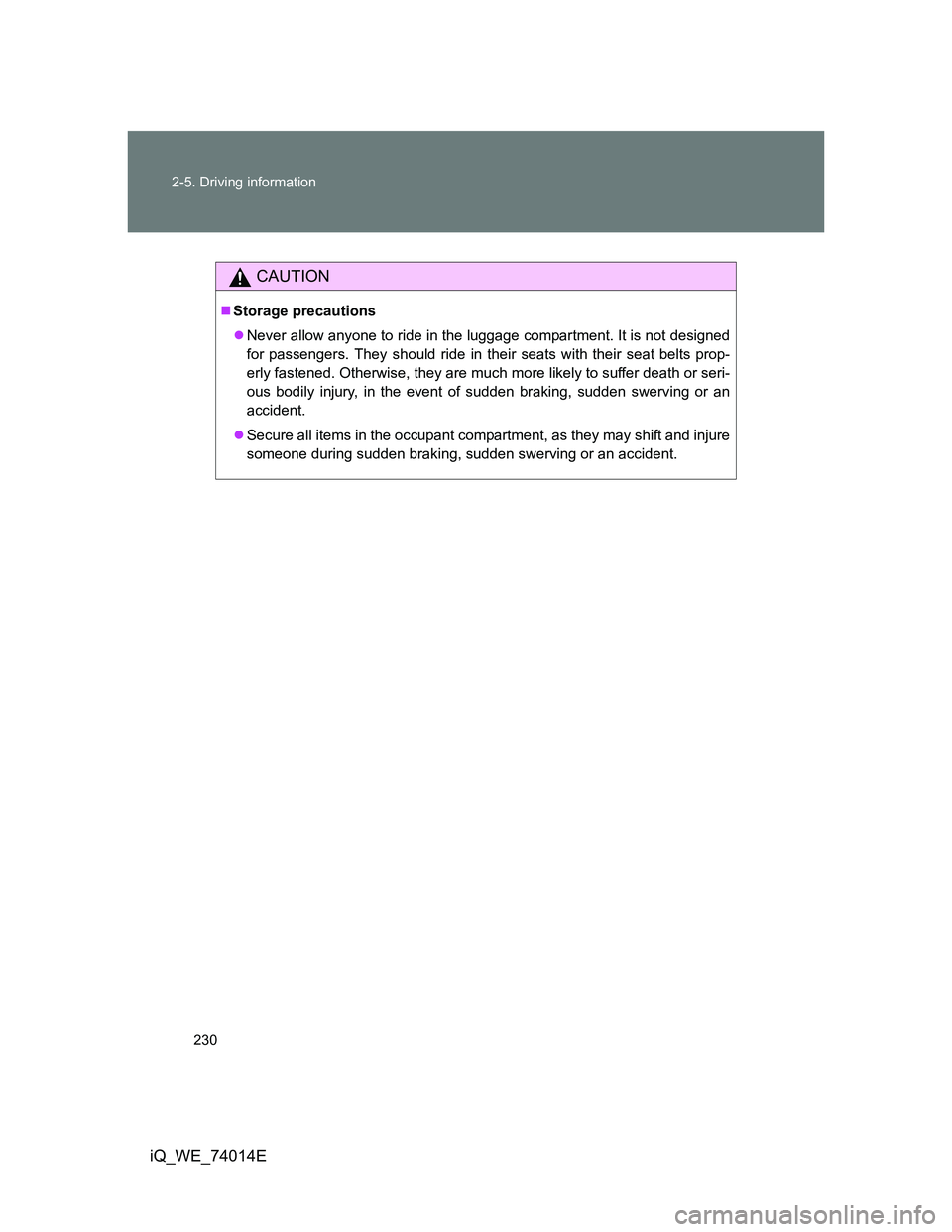
230 2-5. Driving information
iQ_WE_74014E
CAUTION
Storage precautions
Never allow anyone to ride in the luggage compartment. It is not designed
for passengers. They should ride in their seats with their seat belts prop-
erly fastened. Otherwise, they are much more likely to suffer death or seri-
ous bodily injury, in the event of sudden braking, sudden swerving or an
accident.
Secure all items in the occupant compartment, as they may shift and injure
someone during sudden braking, sudden swerving or an accident.